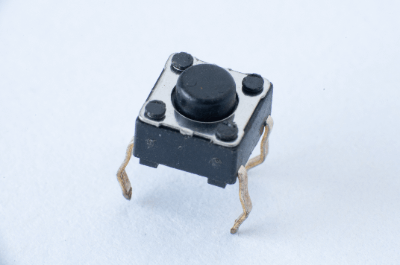What Is a Tactile Switch?
 A tactile switch is a momentary-type switch that is energized by a click when a person presses it.
A tactile switch is a momentary-type switch that is energized by a click when a person presses it.
Tactile” here means “palpable” or “tactile” and is also called a tact switch. Tactile switches are generally installed on printed circuit boards.
They are characterized by the fact that when a switch is pressed; it provides feedback of the sensation of having been pressed. For this reason, they are widely used in all electronic devices that are operated by humans. Installation methods are broadly classified by whether they are inserted into a hole in the PCB or mounted on the surface of the PCB, and further classified by whether they have a seal that is effective in preventing dust, etc.
Uses of Tactile Switches
Tactile switches are used in a wide range of equipment that requires human operation, including communications equipment, office automation equipment, laboratory equipment, medical equipment, and remote control units for home appliances. At the design stage of the board on which tactile switches are used, it is necessary to identify and select whether they are to be embedded in holes or mounted on the surface properly.
If tactile switches are to be used in precision equipment or in machines that have a large loss in case of failure, it is better to select tile switches with a sealed structure that is highly reliable and has waterproofing and dustproofing effects. By using different stroke lengths at the time of pushing depending on the product, it is possible to make a product that can be touched quickly and continuously, or to make a product that cannot be activated unless it is pushed with strong force.
Principle of Tactile Switches
Tactile switches have a mechanism whereby when a plate called a push plate inside is manually pushed, an electric current flows through the switch when the electrical switch contacts formed inside the switch make contact with each other, causing the switch to operate. A tactile switch consists of an enclosure, a push plate, a film, a metal dome, three contacts, and a mounting base.
The metal dome is a conductor with a dome shape. Two contacts are attached to the edge of the dome and another contact is attached to the mounting base in the center of the dome. When the push plate of a tactile switch is pressed by hand, the center of the metal dome is crushed and the contacts in the center of the dome make contact with the metal dome. The contact point and the metal dome make contact, allowing the current to pass through the three contacts and turning the switch ON.
Conversely, when your hand leaves the push plate of the tactile switch, the metal dome and the contact point in the center of the metal dome separate, turning the switch OFF.
Other Information About Tactile Switches
1. Repair of Tactile Switches
Tactile switches are generally durable enough, but they can fail depending on where they are used and how often they are used. Repair will be performed, but in some cases, such as with older products or the manufacturer no longer exists, it may not be possible to request repair. Nevertheless, if soldering can be performed, replacement with a new one by the user can be handled.
Check the part number from the failed tactile switch and investigate whether an identical tactile switch can be obtained. If not, it is not too difficult to find a similar tactile switch based on the external dimensions. This is because tactile switches are standardized to some extent.
2. Axis Color of Mechanical Keyboards
There are several types of mechanical keyboards for PCs, such as red-axis, brown-axis, and blue-axis. These are derived from the fact that key switches made by a German manufacturer, a major manufacturer of key switches for keyboards, have different axis colors for each type. Since the axis color changes for each type of key switch, it is possible to identify the type of key switch by checking the axis color.
Among these key switches, the key switch with a brown shaft is called a tactile type. However, tactile switches are not actually used, but are simply referred to as such by the manufacturer due to the structure of the key switch (i.e., the feel of the keys).
There are six main keyboard shaft colors: red, pink, silver, black, brown, and blue. Each keyboard has a different feel, but this difference in feel comes from the key switch structure, which itself is identical.
3. Tactile Switches and Haptics
In addition to tactile switches, haptics, a haptic technology that creates the feeling of an object as if there is an operation button that does not actually exist, by applying vibration when operating a smartphone, is being actively developed these days, especially by electronics manufacturers.
With the application of advanced interactive communication technologies such as VR and AR, technological progress is very rapid to incorporate haptic technologies that make it seem as if we are touching objects in a virtual space. In the near future, tactile technology evolved from tactile switches is expected to play an active role in areas such as telemedicine and robot operation.